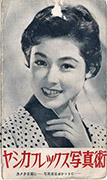66 Models
1954 to 1955
Yashicaflex A-I to Yashicaflex A-III
The 66 Models are in chronological release date order split over seven pages to assist with the speed of displaying images.
The background to 66 Models and the various notes are at the beginning of the first page, 1953-1954.
Models
(Scrolling will take you down to the bottom of the page that you are on, clicking on links will take you to that model regardless of the page that you are on.)
1953-1954 The Simple Beginning |
||
| Pigeonflex | Yashima Flex | |
| Yashica Flex B | ||
1954 A Step Up - Japanese Icon |
||
| Yashica Flex S | ||
1954-1955 Full Range of Models Released |
||
| Yashicaflex A-I | Yashicaflex A-II | |
| Yashicaflex AS-I | Yashicaflex AS-II | |
| MolfoReflex | Yashicaflex C | |
| Yashicaflex A-III | ||
1956-1957 The “Yashica” is born |
||
| Yashica Rookie | Yashica Hi-Mec | |
| Yashica A | Yashica C | |
| Yashica LM | Yashicaflex A2 | |
1957 First Crank Wind and Last “Yashicaflex” models |
||
| Yashica-Mat | Yashicaflex AS (new model) | |
| Yashicaflex B (new model) | Yashicaflex A (new model) | |
1958-1959 The Classics, the 635 and D, Released |
||
| Yashica 635 | Yashica B | |
| Yashica D | Yashica A III | |
| Yashica Auto | ||
1960-1986 Crank Wind Sophistication plus Automation |
||
| Yashica Mat-LM | Yashica E | |
| Yashica Mat-EM | Yashica 24, 12 & Mat-124 | |
| Yashica Mat-124G | Yashica Mat-124B | |
Yashicaflex A-1
aka Yashicaflex A, budget model
Probable release date |
Oct 1954 |
Probable end date |
1957 |
Lens |
Filter Mounts |
Frame Counter |
Shutter |
|||
Make/Type |
Sync |
S/Timer |
Speeds |
|||
Yashimar |
32 mm |
Red Window |
Y.S.K. |
Yes |
No |
B,1/10-1/200 |
Yashimar |
32 mm |
Red Window |
Copal |
X |
No |
B,1/10-1/200 |
(Click on covers for PDF of full manuals, 1954 on left and 1955 on right)
.jpg)
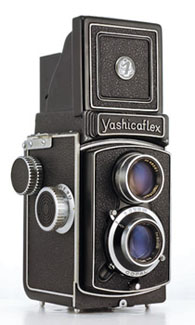
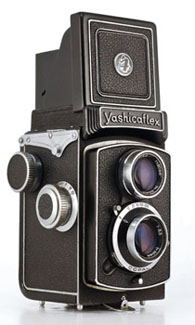
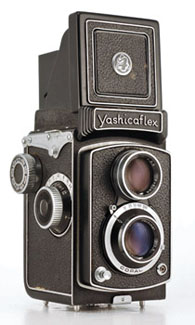
(Image 1 courtesy of Leigh Harris, images 2 to 4, courtesy of Tom Heckhaus)
A basic but well-built camera with film advance by red window. Released in October 1954 at the same time as the A-II, both shared the new budget Yashimar lenses and more limited shutter specs with the metered AS-I and AS-II released a month later. Four versions shown above (the focusing knob end cap of the third camera is not original, it should be the same as the second camera, the first camera end cap is discussed below), refer also to “Yashicaflex A Series”. First has no hood logo, early body, black focusing panel trim, Y.S.K. shutter (logo is “Y.S.K”, all full stops included in a Japanese ad for the A-II, see A-II below), film winding knob with double row knurling and without film speed reminders, side flash sync and cable release shutter. Second adds hood logo, machined focusing panel trim and Copal shutter. Third adds new body and film winding knob with single row knurling. Fourth adds 9 flag film reminder, new type focus knob, front flash sync and new type locking knob/lever later fitted to the Yashica A. Claimed to be in production until mid-1957 but may have been confused with the Yashicaflex A (new model). See also MolfoReflex for more images (an A-I without hood logo and new nameplate).
The very earliest examples have focusing scales in metres and I have generally found them on Japanese websites. Then the largest part of my database is made up of examples with only feet focusing scales and lastly, there is a mix. From my experience of Japanese websites and the lack of any late examples, my conclusion is that except for initial production, this model became export only with the A-II being predominantly for domestic consumption.
Some have incorrectly referred to the A-I as the “model A”. In fact the evidence is that in Japan it was the A-II that was known as the “Yashicaflex model A” (see also Yashicaflex A-II below). To add to the confusion, Yashima sometimes collectively referred to the models A-I and A-II as “Yashicaflex model A” - see the user manual above.
Just under the first half of my Yashicaflex A-I database examples, up to camera 64xxx near the end of the cable release type shutters, and its early MolfoReflex relative had this new type of film winding knob with full width coarse knurling with centre groove (similar to the early A-II with centre button but that disappeared much earlier). The full leatherette insert continued a little longer until the press button shutter release first appeared:
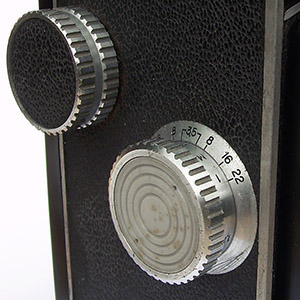 (Image courtesy of Leigh Harris)
(Image courtesy of Leigh Harris)
The light grey focusing knob end cap is unusual and the colour is not found on other Yashima cameras. The design itself is identical to the pattern used by Yashima from the first Pigeonflex in 1953 to until after the introduction of the Yashicaflex model C in September 1955 (the model C itself used the later design). Most Shinano made Pigeonflex IA examples have a similar style end cap that can look grey but their surface appears to be metallic so I don't think that it has been borrowed from one of those. This particular camera, 10817 with lenses 10917 and 10856, has the fourth lowest confirmed A-I body number in my database and the second lowest taking lens numbers. A second example with the grey cap with similar low body number, 10704 (third lowest), has the lowest taking lens number, 10728, with second lowest viewing lens, 10702. The example with earliest body number in the database has the usual black cap but unfortunately, the camera with the second lowest body number is missing its end cap. All later examples have the black cap. It seems that this may have been a design initiative that was abandoned very early on - there are a few Yashima/Yashica examples of similar short-lived implementations.
There are 81 cameras in my database. The earliest example in my database is 103xx with taking lens 112xx and viewing lens 100xx. Second earliest is 105xx with taking lens 115xx and viewing lens 113xx. The next are the two with the grey focusing knob end caps. Including these, there are twenty two examples up to serial number 152xx which all have early type bodies with short strap holders and of which twenty have the edge of the lens board focusing panel painted black as on the preceding Pigeonflex to Yashica Flex B models (the exceptions are cameras 126xx and 141xx with Copal Shutters which have the later machined silver lens board trim):
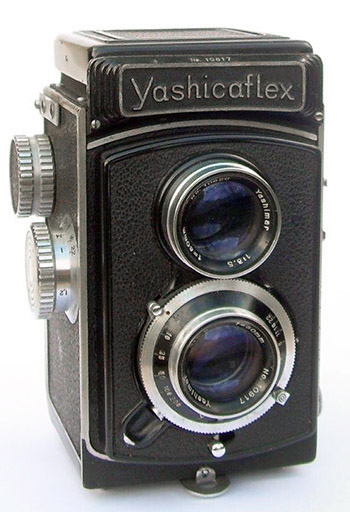 (Image courtesy of Leigh Harris)
(Image courtesy of Leigh Harris)
Of these, sixteen, including the first ten, have the largely unknown Y.S.K. shutter. Close inspection of my Yashicaflex A user manual (shared between the A-I and A-II) reveals the same shutter and trim (see also Yashicaflex A-II below for further Y.S.K. shutter details and similar trim). The name and shutter speeds are displayed on the inner black band whereas on the Copal shutter, they are on the outer silver speed setting ring, or rim:
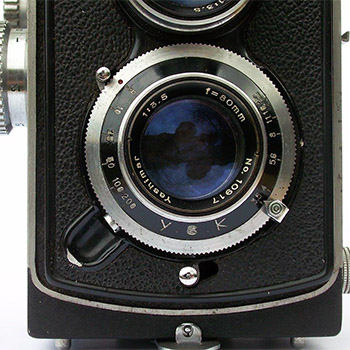 (Image courtesy of Leigh Harris)
(Image courtesy of Leigh Harris)
Lens numbers on the examples with Y.S.K. shutter go to 215xx for the taking lens and 210xx for the viewing lens but as high as 400xx for the five Copal shutter cameras, the first one appearing at body number 122xx. Camera 152xx is the last with Y.S.K. shutter. Somewhere between this and the next camera, 215xx, the number of rings on the tripod mount change from 3 to 2 and the feathers on the arrow tail changed from an outline to filled (solid black). The big gap in numbers suggests a numbering change. Also, up to 152xx, none of the cameras have hood logos and the hood of the next camera, 215xx, is unknown. All examples after 215xx have the first type stylised black “Y” on black hood logo. Possibly also beginning with 215xx but certainly all later examples feature a machined edge to the lens board trim.
There is another big jump in numbers to 616xx with lens numbers continuing on from before with 578xx and 485xx. The change from early body to later body with long strap holders occurred in a mixed transition between cameras 635xx and 639xx.
The following cameras range up to 653xx with taking lens 771xx. These were the last examples with the full width knurling on the film winding knob. The next camera, 792xx, ushers in a new six digit taking lens number of 202xxx. Camera 801xx with taking lens 201xxx and viewing lens 300xxx is followed by a camera with lenses 309xxx and 309xxx. This is the last camera with all black film winding knob (i.e. without ASA film speed reminder) and cable release shutter. It is also the first with the Yashica A style locking lever replacing the Pigeonflex type but there is still the odd earlier type to come. The next camera after this appears to be the first in a new series and has body serial number 112xxx and taking lens 114xxx. This is followed by 116xxx with taking lens 303xxx and 116xxx with taking lens 116xxx (the lens numbers are strangely out of sequence but lens numbers with the Yashicaflex A-I are generally messy). These three are the first with press button shutter and 8 flag film speed reminder but the first and third revert to the earlier Pigeonflex type locking lever again (the last to do so). The camera with serial number just 180 higher is the first to loose the three exposed screws from the spool knob backing plates. The change from early to late focusing knob and move of the sync from the side to front lower right occurred around camera 134xxx. Between cameras 134xxx and 136xxx, the 8 flags changed to 9 on the film winding knob. At around camera 138xxx, the film spools changed to the narrow knurling type and 3 screws in the accessory shoe increased to 4. There are five such cameras, all with body numbers 138xxx. The highest taking lens serial number is 805xxx.
Normally supplied with a dull silver metal push-on lens cap, there are three late cameras with the hard plastic Yashica A type which may be original. These are common on late model AS-IIs.
Yashicaflex A-II
aka Yashicaflex A, budget model with auto-stop film winding
Probable release date |
Oct 1954 |
Probable end date |
Jul 1957 |
Lens |
Filter Mounts |
Frame Counter |
Shutter |
|||
Make/Type |
Sync |
S/Timer |
Speeds |
|||
Yashimar |
32 mm |
Counter |
Y.S.K. |
Yes |
No |
B,1/10-1/200 |
Yashimar |
32 mm |
Counter |
Copal |
X |
No |
B,1/10-1/200 |
(Click on covers for PDF of full manuals, 1954 on left and 1955 in middle, or selected pages from 10 August 1955 edition of Japanese booklet on right)
In respect of a later edition of the Japanese language booklet on the right, Chris Whelan writes: “The user guide translates to the title 'Yashicaflex Photography'. The booklet describes what a TLR is, briefly highlights the various Yashicaflex models, tells how to take pictures and to set up a darkroom and develop your film and make prints.” More here.
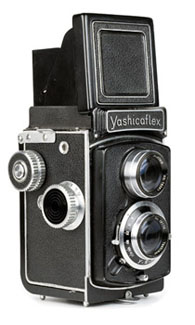
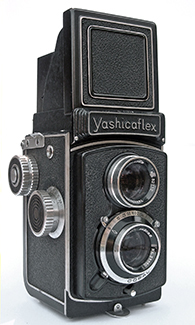
.jpg)
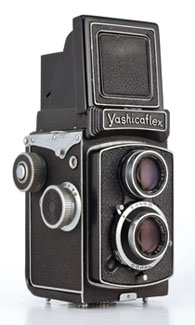
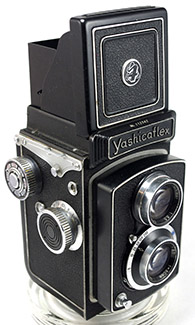
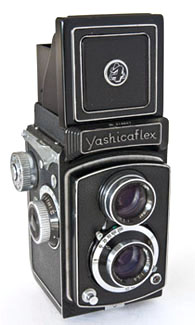
(Images 1 & 4 courtesy of Tom Heckhaus, image 2 courtesy of Leigh Harris, image 5 courtesy of David Johnson)
Adds auto-stop film winding and film counter to the A-I model. Six versions shown (refer also to “Yashicaflex A Series”); first with old body, black lens board trim, flash sync on the side, film wind knob with double row knurling, no hood logo and cable release Y.S.K. shutter. Second is the same but changes the shutter to a Copal. Third has machined lens board trim and film wind knob with single row knurling. Fourth has the new body, new locking lever/knob later used on the Yashica A and the circular ferrule for the cable release is replaced by a threaded plate. Fifth has an eight flag film reminder, press button shutter release and hood logo. Sixth has new style focus knob, 9 flag film reminder and flash sync on the front instead of side. Claimed to be released in October 1954 at the same time as the A-I and in production until mid-1957. The first date seems about right, the second date is less certain but comparing trim changes, I would say both the A-I and A-II models ceased before the AS-II which did make it to mid-1957.
This is the April 1955 cover of Japanese photographic magazine Shashin Kōgyō:
 (Document scan courtesy of Leigh Harris)
(Document scan courtesy of Leigh Harris)
From this angle, the A-I and A-II are identical. Contributor Leigh Harris tells me that it is an A-II and inside is a four page comparison with an equivalent Taiyoda made Beautyflex. Note that it has machined lens board trim and Copal shutter already.
Although there is the odd example with a feet focusing scale in my database and there is only one confirmed metre scale in the last nine, production was very heavily skewed towards cameras with metre scales. Along with the Yashicaflex C, it is one of the most commonly found models on Japanese auction sites. In Boxes, I note that the Yashicaflex A-I box is simply marked “Yashicaflex model A” and the Yashicaflex A-II box is marked “Yashicaflex model A-II” but that a significant number of A-IIs have been found with the “Yashicaflex model A” box and one even with a an outer box marked the same way with serial numbers matching the camera, as far as I can remember, mostly, or all, from Japanese sites. Yashima collectively referred to the models A-I and A-II as “Yashicaflex model A” but in Japan, guarantee documents suggest that with effectively only the one model, the A-II was known as the “Yashicaflex model A”. This seems to be confirmed by the Japanese Yashica Flex Photography booklet linked above and also this page from a 1956 Japanese brochure (the Japanese character after the “A” on the green background translates as “Type”):
 (Document scan courtesy of Chris Whelan)
(Document scan courtesy of Chris Whelan)
Y.S.K. Shutter
Twenty five of the earliest examples of the A-II in my database are fitted with a virtually unknown Y.S.K. shutter of similar spec to the Copal of later cameras except that Y.S.K. shutters has the aperture scale upside down compared to Copal shutters and the shutter speeds are on the black inner ring making that scale also appear to be upside down. The only link that I can find to Y.S.K. shutters is its use on some versions of the Japanese medium format New Semi Renky cameras made by Rengō Kōki in the period 1939 to 1943 (Camerapedia and Camera-wiki.org). Eleven similar Yashicaflex A-I cameras in my database were found on Japanese auction sites, however, there are photos of many more of both models but without discernible serial numbers. All cameras with the Y.S.K. shutter also have the edge ridge of the focusing lens board painted black like the earlier Yashica Flex B and previous models (as do the first examples with Copal Shutter).
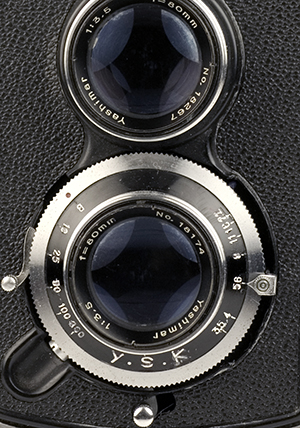
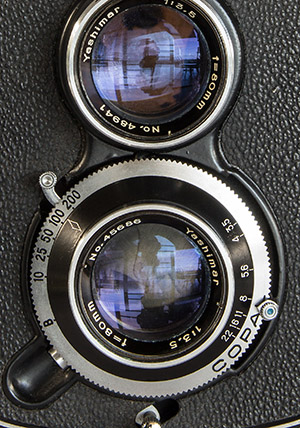
(Left image courtesy of Tom Heckhaus)
Detail on left from top left camera, detail on right from an early A-II with Copal shutter.
As noted for the Yashicaflex A-I, the combined Yashicaflex Model A user manual has a photo of an example (actual A-II) with the Y.S.K. shutter. The Japanese ad further below also mentions it.
Film Winding Knobs
The Yashicaflex A-II had auto-stop film winding so needed a release button in the film winding knob. Early cameras, until the press button shutter was introduced, generally had a black leatherette insert instead of the film type and/or speed reminders of the more expensive models. All examples with the Y.S.K. shutter and those first few with the Copal shutter and black edge trim to the front lens board panel have a unique style film winding knob with full width knurling similar to the early Yashicaflex A-I and MolfoReflex:
 (Image courtesy of Tom Heckhaus)
(Image courtesy of Tom Heckhaus)
The first six examples in my database with Y.S.K. shutter and the winding knob visible have a film winding knob with a metal disc instead of the leatherette insert. There is also a slightly later group of five plus two more examples. A slightly messy transition but the serial numbers are all close. Note that the button is different too - it has an inside black ring and is probably the same as the first Yashica Flex S type whereas the button on the leatherette type appears to be the same as the Yashica Flex Model S with Copal shutter.
(Click on image for larger size)
(Left image courtesy of Sandu Baciu, right image courtesy of Tom Heckhaus)
Later cameras received the film speed reminders from the more advanced models, first with the 8 flags and then the 9.
Focusing Hood Logo
Although the more up market model of the A-I/A-II duo, but probably because of its Japanese market focus (all/most export models had hood logos, some lower end domestic only models did not), the A-II did not receive its hood logo until the cable shutter release was replaced by the press button type towards the end of the production run (batch of cameras with 112xxx numbers before a general change after camera number 122xxx). This was much later than the A-I.
Trim & Feature Changes - By Serial Number
There are 192 cameras in my database. Being from the same period as the Yashicaflex A-I, lens numbers are sometimes not as consistent as at other times - I think that there are often two or three different number ranges running at the same time e.g. lens numbers change from 1xxxxx to 3xxxxx to 2xxxxx and following cameras can have numbers from anyone of the three ranges, but they are generally increasing.
The earliest camera possibly has a serial number starting with 15xxx, taking lens 234xx and viewing lens 164xxx. Other numbers include 160xx with taking lens 231xx and 175xx with taking lens 252xx. Camera 177xx with taking lens 269xx, camera 180xx with taking lens 214xx and camera 187xx with taking lens 279xx are owned by contributer Sandu Baciu. Camera 197xx with taking lens 18174 is owned by Tom Heckhaus and featured above. The last camera with Y.S.K. shutter is 20557 with taking lens 30562 and viewing lens 29485.
Two slightly earlier cameras, but with slightly higher lens numbers, have the new Copal shutter already; 195xx with taking lens 380xx and 203xx with taking lens 319xx.
The first 6 of the early cameras with tripod mount visible have the earlier 3 ring type. Tom's 197xx has the new style two ring mount already but so does perhaps a slightly earlier camera with only lens numbers visible.
There is an odd block of six cameras starting with the camera in the ad below which is from the April 1955 edition of Shashin Kōgyō (cover featured above). Its serial number is 23712 with taking lens 37106 and viewing lens 36966. All six feature later trim items including silver focusing panel edge and half width knurling on the film wind knob. The lens numbers match those features but the body serial numbers are too low, as if someone has discovered a box of earlier pre-numbered nameplates and decided to use them up. The last camera in the group is 246xx with lens numbers 394xx and 385xx. The highest lens numbers are 412xx and 414xx. Even more oddly, two of the cameras, both 241xx, revert to the earlier 3 ring tripod mount, so maybe unused earlier backs were also being used up.
(Document scan courtesy of Leigh Harris)
(Note, this ad says that the camera is available with either Y.S.K. or Copal shutter, the only instance that I have seen the Y.S.K. mentioned by Yashima. The ad must have been from near the cut-over point with cameras with the Y.S.K. shutter still for sale in the market place.)
Somewhere in the 25xxx range and taking lens number 35xxx is the last A-II with the black edge trim to the focusing lens board. The following camera in the database changed from full width to half width knurling on the film winding knob. Camera 320xx with taking lens 52xxx (the previous camera, 319xx has lens 53xxx) is one of the last with the early short strap holder body. Body numbers then jump by about 30,000 to 60xxx but oddly, this is actually the last camera with the old body! Lens numbers are 53xxx and 47xxx. Also odd is that this camera was for sale in Japan but has the rare, for an early example, focusing scale in feet.
The first example with new long strap holder body is 61xxx whilst lens numbers continue on much as before. This block of body numbers continue to 122xxx by which time lens numbers reach 129xxx but interspersed with these lens numbers are lens ranges 202xxx to 242xxx and several cameras with 300xxx to 320xxx. Camera 90xxx is interesting because it has the date, “Jan 26 1957”, stamped inside it. It is unlikely to be anything to do with production but could be a sale or repair date. Camera 111xxx is the first with the Yashica A type locking lever instead of the earlier Pigeonflex type.
There is a second very odd block of ten cameras with body numbers 1121xx to 1127xx which look like later cameras (eight examples with 8 flag film speed reminder instead of leatherette insert and press button shutter instead of cable release, two cameras without screws in the spool knob backing plates and all ten with focusing hood logos). It is a bit hard to tell with lens numbers as three series seem to be running simultaneously, but they seem to match the body numbers. These cameras are followed by a lot of examples with the earlier features still: 1129xx to 1241xx. Just before 118xxx, the screws in the spool knob backing plates disappeared.
A new range of numbers begins with camera serial number 213xxx which has the new trim first seen on the earlier 112xxx examples: the film winding knob with black leatherette in the outer ring changes to 8 flags, the cable shutter release changes to press button and the focusing hood finally gets its logo – except for three random examples (in addition to the 112xxx examples), the earlier cameras had no logo. The lens numbers start with 328xxx and seem to progress in leaps and bounds. Less than 136 production cameras later, the flash sync moves from the side to the bottom front. There are several more cameras in the database, then 213xxx, some 600 units higher than the first of the series, adds 9 film reminder flags instead of 8 on the winding knob, late spool and focusing knobs, and 4 instead of 3 screws in the accessory shoe. Last camera is mine with body number 214647, taking lens 769704 and viewing lens 771003. Mine came with the usual silver metal push-on style lens cap but the previous camera has the hard plastic Yashica A type which is also common on late AS-II examples.
Yashicaflex AS-I
aka Yashicaflex AS, lower mid-range model with plain filter mounts, Sekonic CB-1 meter and red window
Probable release date |
Nov 1954 |
Probable end date |
? |
Lens |
Filter Mounts |
Frame Counter |
Shutter |
|||
Make/Type |
Sync |
S/Timer |
Speeds |
|||
Yashimar |
32 mm |
Counter |
Copal |
X |
No |
B,1/10-1/200 |
(Yashicaflex AS manual is provided courtesy of Tom Heckhaus)
(Click on covers for PDF of full manuals, 1954 on left and 1955 on right)
The Yashicaflex AS-I is called “AS-I” in the first manual and simply “AS” in the second but the presence of its sibling, the AS-II, in both manuals makes it clear that the AS-I/AS is a separate model to the AS-II. It can be viewed as a Yashicaflex A-I fitted with the Sekonic exposure meter shared with the Yashicaflex S and AS-II or a Yashicaflex AS-II with red window instead of film counter and of course film winding knob without release button.
The AS-I is also very difficult to find. The only hard evidence I have seen of this model is in the two multi-model Yashicaflex user manuals above (see also “Yashicaflex A Series”), which only make passing reference to it, and in a bit of Yashima marketing, it is also listed at the end of the Yashicaflex A user manual as one of five available models. It is again listed as the “AS” with its sibling identified as “AS-II”, both with almost the same specs and both including built-in “Electric Exposure Meter” but with “semi-automatic winding” added for the AS-II. I say “almost” because the “AS” shutter is listed as a Copal with 1/10 to 1/100 speeds which I am almost 100% certain is a typo (it wouldn't be less than the A-I that it is based on).
There is also a doubtful photo, simply titled “Yashicaflex”, taken from the meter side and a production number of 5,824 cameras quoted in the book, “Collector's Pictoral Encyclopaedia & Value Guide to 6x6 TLR Cameras” by Karl F. Kahlau. The photo originally appeared in the Swedish importer Molander & son 1955-56 catalogue under the heading “Yashicaflex AS” (page 15, printed May 1955, catalogue kindly donated by Göran Årelind). More on this below. In fact, I think that Karl has become confused by Yashicaflex AS-I, AS-II and AS (the 1957 model without exposure meter) models and the way the names were sometimes used interchangeably. In his listing of models, Karl only lists the “1954 Yashicaflex AS-I” and “1957 Yashicaflex AS-II” (which should simply be the “Yashicaflex AS”). On reflection, I believe that his Yashicaflex AS-I is actually the Yashicaflex AS-II. Either way, he missed one of them.
Below is the Molander and son catalogue page (Molander & son is an important player in early Yashima history - see MolfoReflex):
(Click on page for larger version)
The machine translated Yashicaflex AS description reads:
A slightly simpler model, but also with built-in exposure meter. Equipped with it in its price range, very sharp drawing, three-piece Yashimar 1: 3.5 / 75 mm object. 'T Shutter with shutter speeds from 1 / 25-1 / 200 sec. Flash connector, self-timer. The camera house is the same as model S, but without counting. Even the exposure gauge is the same as on the more expensive model.
Unfortunately the evidence is a mixed bag. Most of the description could relate to either AS-I or AS-II but the statement “the camera house (body) is the same as model S, but without counting” can only mean that the frame is set by red window, i.e. it is an AS-I. Or is it? On the negative side, the camera's serial number is 30126 which just happens to be the serial number of the AS-II that appears several times in the Yashicaflex AS user manual. That doesn't really mean anything but it does add to the air of improbability, e.g. the lens is listed as 75 mm when it is 80 mm, a self-timer is claimed when one doesn't appear on A-I, A-II or AS-II cameras.
Did it exist? Probably, almost certainly, I think. If there had been a change in mind by Yashima, it wouldn't have been mentioned in both 1954 and what I think is the second half of 1955 for the later manual but I suspect that a lot less than 5,284 examples were produced. In fact, I am pretty certain that the production figure also belongs to the Yashicaflex AS-II. Models that had a domestic market focus turn up reasonably frequently on Japanese auction sites, so like the AS-II, it could have been intended for export. With perhaps not many made, an example may just be taking a long time to reach the marketplace. Japanese site 66tlr.com thinks it existed (note that the names used are “AS” and “ASII” for the two models and the descriptions are back to front). I am also heartened by my first sighting finally in 2015 of a Yashicaflex A-III (with Seikosha shutter) and that model was only mentioned once in Yashima literature.
Yashicaflex AS-II
aka Yashicaflex AS, mid-range model with plain filter mounts, Sekonic CB-1 meter & film counter
Probable release date |
Nov 1954 |
Probable end date |
Jun 1957 |
Lens |
Filter Mounts |
Frame Counter |
Shutter |
|||
Make/Type |
Sync |
S/Timer |
Speeds |
|||
Yashimar |
32 mm |
Counter |
Copal |
X |
No |
B,1/10-1/200 |
(Yashicaflex AS manual is provided courtesy of Tom Heckhaus)
(Click on covers for PDF of full manuals, 1954 on left and 1955 on right)
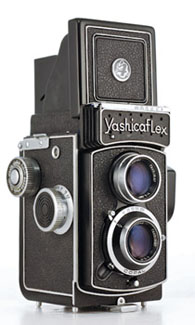
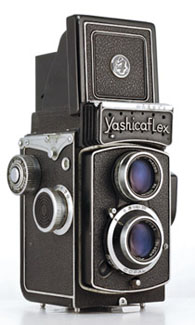
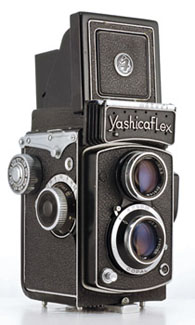
(Images courtesy of Tom Heckhaus)
Three versions shown (refer also to “Yashicaflex A Series”); first with early body and cable release shutter, second with new body and third with press button shutter release, new style focus knob, front sync and moulded type locking lever. Claimed to be released in November 1954 (i.e. one month after the A-I and A-II). That date seems about right and explains why none have been found with the Y.S.K. shutter (see below). I am guessing that the AS-II lasted well into 1957 at least and perhaps longer than the A-I and A-II. Unlike most examples of the other two siblings, the second half of the cameras in my database have the hard black plastic lens caps commonly associated with the Yashica A and the Yashica Rookie (with “Rookie” on it) released in 1956. Also unlike the other two models, the last three AS-II examples have the new focusing hoods with white triangle in the logo, single silver square, split parallel bars on the rear and two reinforcing panels instead of three. These three examples have also lost the film counter reset button (which makes them later than any Yashicaflex S in my database). Like the third example above, the last eight cameras have moulded locking levers instead of the earlier bent strap. The first Yashica-Mats released in 1957 still had the bent strap type.
The Camera
Basically a Yashicaflex A-II camera fitted with the Sekonic CB-1 meter from its more sophisticated and expensive sibling, the Yashicaflex S. Yashima documentation refers to this model as the AS-II and so far elusive red film window variant as the AS-I. The user manual covers both models and collectively calls them “Yashicaflex AS” (more in Yashicaflex A Series). The page below (from the full brochure which also explains the difference between the models A-I and A-II) also appears in several other places on the site but it is the clearest (although not only) confirmation of the model's correct name. Many sites do not get it right, calling it an “early Yashicaflex S”, “Yashicaflex AS” or “Yashicaflex AS-I”.

(Brochure courtesy of Tom Heckhaus)
Normally found with Yashimar lenses in a Copal 1-1/200 shutter. However, after discovering early versions of the Yashicaflex A-I and A-II with Y.S.K. shutters, a close inspection of the Yashicaflex AS user manual revealed that whilst the example shown inside the cover is fitted with a Copal shutter, other photos have clearly been “doctored” with “Copal” appearing crudely and differently in white on two photos where it normally appears in black on the silver outer ring (black pen on negative?). The other three photos on the double spread appear to have no shutter branding. The black inner ring where “Y.S.K.” is normally expected to have been found, also appears to have been modified on all five. Also, Y.S.K. shutters have the speed and aperture scales upside down compared to Copal shutters, as these ones do. There are also some photos which have Pigeonflex type locking levers. After comparing them to the photos in the Yashicaflex A (A-I and A-II) manual, I actually think that most of the dodgy photos, including those with the Pigeonflex locking lever, are reused from the Yashicaflex A manual (appropriately cropped to hide the fact that the A-I and A-II did not have meters), possibly as a cost savings measure. Therefore, using this manual to identify features has to be tempered with the question, "what am I actually looking at?" Whilst there may be examples with the Y.S.K. shutter, the manual is of no help and actually makes me doubt that because of the attempts to disguise the name, unlike in the Yashicaflex A version.
All photos in the manual, including those confirmed as of the AS-II model, uniquely have the same black lens board trim as the first sibling models, no hood logos and film winding knobs with full width knurling and black leatherette in place of film type/ speed reminder flags. I have not discovered any examples with these features in the wild yet.
Only 11 of the 83 Yashicaflex AS-II cameras in my database have the earlier body whereas with the Yashicaflex S, it is just under half. Another indicator of relative ages.
Comparison of Yashica Flex S and Yashicaflex AS-II Metering
Correspondent and exposure meter aficionado Simon A. Spaans has identified a difference in the meter reading arrangements between the Yashicaflex S and Yashicaflex AS models. This is demonstrated in the two composite images below provided by Simon. Note that the Yashicaflex S readout on the left uses a 1-7 light value scale. The appropriate ASA speed on the sliding scale on top is set against the light value and shutter speed and aperture settings combinations can be read off. The Yashicaflex AS-II on the right has a readout with f/stop numbers. The scales on top now have different functions – the sliding aperture scale is lined up against the appropriate ASA number and the shutter speed read off.
Whilst the process is slightly different, the functionality seems the same. However, I think that it is far more intuitive to transfer the integers of the light value reading than dealing with arcane f/stop relationships, e.g. it would be easier to read and transfer 5.5 than halfway between f/11 and f/16. Initially I thought that Yashima was looking to differentiate the two models further on the basis of usability even though there could not have been any cost differences in the components but, the Yashica LM, which was the replacement for the Yashicaflex S, has a similar readout arrangement as the AS-II. Perhaps Yashima had a change of mind about what worked best and the AS-II as the later camera received the latest thinking? Who knows?
(Images courtesy of Simon A. Spaans)
(Click on either image for combined larger view)
Confirming that both cameras and both exposure reading methods existed concurrently, the Model S & AS attachment (presumably covering both AS-I and AS-II variants) referred to in the main part of Yashicaflex Directions for Use Models A & C details the procedures for the two different exposure setting methods:
(Click on image for larger view)
Later cameras destined for European export have the 10 flag DIN scale film reminder on the film winding knob. To match this, the exposure calculator on top of the camera has a DIN scale in place of the usual ASA type:
 (Detail from larger web image)
(Detail from larger web image)
Trim & Feature Changes - By Serial Number
The first camera in my database is actually from the Yashicaflex AS user manual or “Directions”. It has body serial number 30126 and has all the expected early features including short strap holder body, cable shutter release, side sync, early spools, Pigeonflex type locking mechanism with bent strap lever and early focusing knob. However, it is the only camera with the early A-II style film winding knob with full width knurling and black leatherette in place of film speed reminder, with no hood logo and also the only one with the serial number on the nameplate flap like the S models with NKS-FB shutters but later script style already. The user manual also uses a photo (page 5 with flap up) which is not 30126. This may have a serial number starting with 2. The camera has plain filter mounts in the style of the Yashicaflex A series but the flap script is in the style of the Yashica Flex S. Likely to be an even earlier pre-production example.
The two cameras from the user manual:
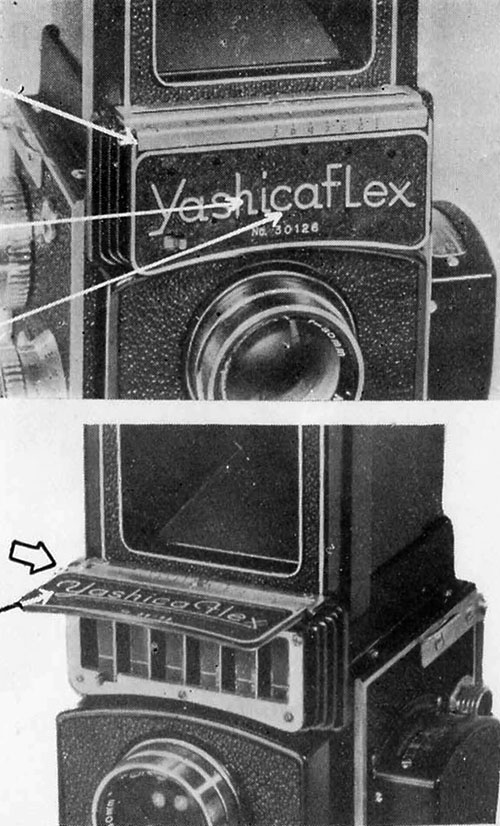
As mentioned above, camera 30126 has a Copal shutter already but black lens board trim still. It may be a pre-production example. One feature it and the later cameras already have is the leatherette insert on the meter cover (see user manual), unlike the earliest S examples with a plain enamelled cover. Further reassurance for those that are still uncertain about which camera came first.
The camera in this ad in the August 1955 edition of Swedish magazine Foto is the same AS-II as in the user manual. The middle digits on both are 012 but a higher quality image of the same picture also appears in the Molander & son 1955-56 catalogue where the serial number is clearly 30126:

(Document image courtesy of Göran Årelind)
The earliest camera found in the wild is 30302 with 38400 taking lens and 43943 viewing lens. Even though it is only 176 cameras after the user manual example, this already has the new nameplate flap, film winding knob with half width knurling and the early S model hybrid 6 flag film reminder, silver lens board trim and hood logo.
(Image courtesy of Chris Whelan)
Contributor Chris Whelan also owns the next camera, 31147, which doesn't feature the “Made in Japan” of most other examples.
The next camera is 815xx. It seems that there was a change in the numbering range very early on. Four similar cameras follow, then my 81744 with taking lens 90197 and viewing lens 19934 followed by 817xx, some 20 cameras later, with taking lens 880xx and viewing lens 881xx. The following camera, 821xx, is the first with the long strap holder body. Camera 831xx also gets the 8 flag film reminder and press button shutter release and is the first to lose the three exposed screws from the spool knob backing plates. Camera 835xx has the first confirmed new style locking knob but this probably first appeared with the new body. The following slightly higher 835xx serial number is the last in this series.
The first camera in the new series is 198xx. This is followed by 205xx which is the first with the sync moved from the side to the lower right front. I will include some taking lens numbers here as they go a little strange - this one has jumped to 361xxx. Camera 206xx is the first with the late style focusing knob. Between this camera and 211xx, two things happened; the first Yashicaflex AS-II example with the 10 flag DIN scale film reminder and therefore destined for European export and for subsequent cameras, the 8 flags on the film winding knob changed to 9. Between camera 215xx and 217xx, the lens caps changed from silver pressed metal to the black hard plastic Yashica A type. Camera 226xx (lens 560xxx) is the first with late spool knobs and between this and camera 231xx (lens 700xxx) the locking lever changed to moulded type.
The third last camera has serial number 236xx and lens numbers 803xxx and 620xxx and has the 10 flag DIN reminder scale. It is the first example without the film counter reset button, i.e., fully automatic reset and is the first camera in my database to loose the second silver square on the hood and get the revised black-white-black hood logo with split parallel bars on the rear of the hood. The second last camera with lens numbers only, 846xxx and 753xxx, also has the 10 flag DIN scale and updated trim. The last camera, also with lens numbers only, 886xxx and 886xxx, has the updated single silver square on the hood and the revised black-white-black hood logo and split parallel bars. It has a feet focusing scale and 9 flag ASA scale film speed reminder. The side of the camera where the reset button would be found is not visible.
I would say that this camera was specifically targeted at export. This may be the first such model. Whilst from the Yashicaflex S onward, there have been models with focusing scales in both metres and feet, the AS-II is heavily skewed towards feet for the US market and I don't recall seeing one on a Japanese website. The model A-I was also heavily skewed towards feet but not the first examples with the Y.S.K. shutter which are mainly found in Japan. Of the 50 AS-II cameras in my database, 31 have been identified with feet scales and 10 with metre scales. Of the 10, 4 have the 10 flag DIN flag film speed reminder of cameras bound for Europe, on 3, the film reminder is not visible and the earliest three have either the 6 or 8 flag ASA film speed reminder for which there doesn't appear to be a specific DIN counterpart.
By serial numbers alone, I am guessing that the production run was somewhere around 6,000 cameras and that fits with author Karl Kahlau's 5,824 produced between November 1954 and June 1957. He is referring to the Yashicaflex AS-I but I think he means the AS-II - he mistakenly calls the 1957 Yashicaflex AS a Yashicaflex AS-II, perhaps using the logic that “II” makes it later (if nearly 6,000 AS-Is had been made, surely one would have surfaced by now?). Whilst 5,824 seems to be a respectable number, it is quite low for almost three years of production. Because of the export focus, they do turn up on eBay from time to time.
MolfoReflex
Rebadged Yashicaflex A-1
Probable release date |
early 1955 |
Probable end date |
early 1956 |
Lens |
Filter Mounts |
Frame Counter |
Shutter |
|||
Make/Type |
Sync |
S/Timer |
Speeds |
|||
Yashimar |
32 mm |
Red Window |
Copal |
X |
No |
B,1/10-1/200 |
.jpg)
.jpg)
.jpg)

(Images 1 to 3 courtesy of Göran Årelind, image 4 courtesy of Sandu Baciu)
The first camera is from towards the beginning of the series, as is the camera in the photo in the ad below, the second camera is the second type with the new body shared by all Yashicaflexes in production at the time and is the last example with cable release. The third type (not shown) is like the second camera but with press button shutter and the knurling on the film winding knob half-width instead of full-width. The third camera is the fourth type MolfoReflex and adds the 8 flag film reminder on the film winding knob. The fourth example above is the fifth type MolfoReflex and has the new focusing knob, 9 flag film reminder and front sync. These are clearly rebadged Yashicaflex A-I models and this is confirmed by the specifications in the ad. None have hood logos. As well as the five distinct trim variations, there were three separate groups of serial numbers (see below) so the cameras were obviously delivered in separate batches.
Note that many sites, including Wikipedia, claim that the MolfoReflex dates from 1953. Someone, somewhere with some clout has made a quite ridiculous mistake and this has been mindlessly copied by others. In 1953, Yashima was just getting going with its Pigeonflex and then Yashima Flex. To make it clear, the MolfoReflex is unquestionably a rebadged Yashicaflex A-I. It is generally agreed that the A-I was released in October 1954. The following discussion makes it clear that a 1955 release of the MolfoReflex is more likely than a late 1954 date.
The Swedish Connection
Commonly written as MolfoReflex as it appears on the nameplate and also in the Swedish ad. The story that appears on a number of sites is that the Swedish Yashica importer, Molander & son AB (aktiebolag or company), ordered 1,000 Yashicaflex cameras rebadged as MolfoReflexes but only about 400 were eventually delivered. It is a little more complicated than that. Molander & son (Swedish ads from the period never show the “s” of son in upper case, always lower case), a family company formed in 1921, was the first importer of the Yashima Flex and Yashicaflex models with the first ad for these appearing in 1954. However, previous to this, in 1949, a separate family run subsidiary was formed, Molanders Fotoagenturer (Molanders Photo Agency), and in 1951 moved to separate premises. It also was an importer and distributer of photographic equipment and perhaps operated under the umbrella of Molander & son but it never directly advertised any Yashima/Yashica branded products.
Göran Årelind has searched through whole series of magazines, the only MolfoReflex ad he has found is this from 1956, run in both April and June editions of a Swedish photographic magazine. It indicates that the “Generalagent” (importer/ distributer) is Molfo Aktiebolag.
(Document image courtesy of Göran Årelind)
(Click on ad for larger view)
The name “Molfo” first appeared in a Molanders Fotoagenturer ad in September 1954. It is likely that it was simply a contraction of “Mol”anders and “Fo”toagenturer. The first time that the company, Molfo Aktiebolag, was identified in an ad was in March 1955. Why the two companies, Molander & son and Molanders Fotoagenturer/Molfo, and how were they related? Was it simply a business device to do with marketing or taxation matters or were they more separate than that?
As the Yashicaflex A-I is claimed to be released Japan in October 1954 and no MolfoReflex has been found with the first Y.S.K. shutter and/or black lens board edge trim and allowing for shipping times, it is probable that the first MolfoReflex was not marketed until at least early 1955. That would match the trim of both the camera in the ad and Göran's earliest example. Comparing the trim of the last MolfoReflexes in my database to their Yashicaflex A-I siblings and other models, it is possible that they are from quite early in 1956 and the ads were run after the last of the 400 MolfoReflexes was delivered. Why was there no advertising for the first 12 months or so? Margins on 400 low price cameras wouldn't allow much advertising budget. This was a time still when Japanese cameras were not well regarded and in any case, as a “Swedish” camera, the MolfoReflex had no history and not a lot to offer the discerning photographer. Perhaps the ads were placed to help move unsold stock? Was the rest of the order canceled? It may explain the shortfall between the original order and the claimed delivery of 400.
There are separate 1956 and 1957 ads by Molander & son, which include the Yashicaflex S and AS (1956 only) as the only Yashima sourced cameras (a new importer for “Yashica” models started advertising in April 1957) and by Molfo AB for items other than the MolfoReflex with still no mention of Yashica.
Göran has been investigating the link between the two Molander companies and his findings and other Swedish Yashica related material can be found on the Yashica page in the “Sweden” section and his document:
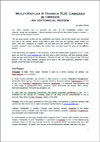 (Click on page for full document)
(Click on page for full document)
Molander & Son still exists today (“S” of son appears in upper case now) but Molfo AB was closed down in 1961. The name remained registered to Molander & Son until it was sold in 1999.
The Camera
Both, because there are so few photographs available elsewhere and also because the photographs reflect Yashicaflex A series development, here are some more of the four versions from above:
(Images of 1st 3 cameras courtesy of Göran Årelind, images of 4th camera courtesy of Sandu Baciu)
(Click on images for larger view)
The lens caps are typical silver Yashicaflex A series slip-on type but without any name. The ever-ready cases are typical Yashicaflex A-I type but without the ribbing on the front (somewhat like the Yashica A case that came later) and also no names or other identification. A lens cap and case can be found on the Lens Caps, Cases & Boxes page.
Serial Numbers & Quantity
Three blocks of serial numbers have been found; 85xx to 86xx for first type cameras, 1140xx to 1141xx for second type cameras and 313xx to 315xx for third, fourth and fifth type cameras. Compared to Yashicaflex A-I serial numbers, the first block are completely unique, the second block are somewhat similar to A-I numbers from the same period and the third block appear to be completely unique again (the A-I continues with 6 digit numbers to 138xxx). The table below shows the maximum possible number of cameras that can fit into those ranges. There could still be some cameras from outside of those ranges which would push the total up. It is also possible that there may have been some gaps e.g., at the change over from third to fourth type cameras between 313xx and 314xx, there is a gap of 60 cameras - was there a real gap or just cameras not yet found? The 400 claimed looks to be pretty close, certainly somewhere between 400 and 500 seems about right.
Serial Numbers |
1st Block |
2nd Block |
3rd Block |
Total |
| Highest in block | 86xx | 1141xx | 315xx | |
| Lowest in block | 85xx | 1140xx | 313xx | |
| No. of cameras | 125 | 66 | 282 | 473 |
Trim & Feature Changes - By Serial Number
Given the extremely limited production run, I was amazed at being able to turn up 25 cameras with body serial numbers and one with lens numbers only! The first six serial numbers are in the 85xx to 86xx range. They are typical early bodied (short strap holder) Yashicaflex A-I types including the full width knurling on the film winding knobs. The new body type is ushered in by four cameras in the 1140xx to 1141xx range. These were the last with cable release.
The last sixteen cameras have five digit numbers ranging from 313xx to 315xx. The first example has already lost the three exposed screws from the spool knob backing plates and the full width knurling on the film winding knob has changed to outside half only but still with plain black leatherette insert. At 314xx, something strange happens, both type 4 and type 5 cameras appear to be mixed in together. The first are actually type 5s with the 9 flag reminder on the film winding knob, new focusing knob and front sync followed by several type 4s with 8 flags, early focusing knobs and side sync.
There were no such issues with the Yashicaflex A-I serial numbers. What I think may have happened is that these were all part of the last batch delivered which coincided with the changeover of trim types on the Yashicaflex A-I production line. Cameras were probably taken off the production line at some point to be fitted with their new nameplates (and serial numbers) and whoever fitted them, didn't take the effort to match trim to numbers.
Clearly, they must have been delivered in dribs and drabs over an extended period almost as long as the Yashicaflex A-I production run itself. However, as there are yet no examples with 4 screws instead of 3 in the accessory shoe or with late type spool knobs and only four with the flash sync on the front and new focus knob, delivery probably did finish in early 1956.
Yashicaflex C
Premium model, meterless
Probable release date |
Sep 1955 |
Probable end date |
Jun 1957 |
Lens |
Filter Mounts |
Frame Counter |
Shutter |
|||
Make/Type |
Sync |
S/Timer |
Speeds |
|||
Yashikor+ Tri-Lausar |
Bay 1 |
Counter |
Copal |
X |
Yes |
B,1-1/300 |
(Click on first cover for PDF of full English language multi-model manual or selected Japanese pages on right)
Scans of Japanese language booklet on right provided courtesy of Chris Whelan who writes: “The user guide translates to the title 'Yashicaflex Photography'. The booklet describes what a TLR is, briefly highlights the various Yashicaflex models (namely model S, A-II and C), tells how to take pictures and to set up a darkroom and develop your film and make prints. A small removable supplement, 6 fold out pages, describes the model C and how to use it. The booklet is reprinted October 20, 1955.” More here.
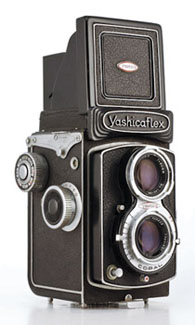
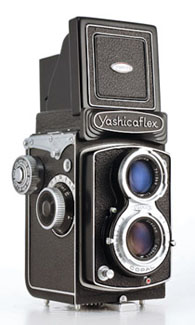
(Images courtesy of Tom Heckhaus)
On the left, 8 flag reminder, early focusing knob, side sync and bent strap locking lever. On the right, a very late example with 9 flag reminder, late focusing knob, front sync (just visible, top right), moulded locking lever and black Yashica oval between the lenses and black aperture scale. Both with film counter reset button. Although released later, meterless companion camera to metered Yashicaflex S - both seemed to last into the middle of 1957. Unusual in that Tri-Lausar viewing lenses were used in conjunction with Yashikor taking lenses. The style of the unique hood logo with the word “Yashica” in an oval surround is shared with the rare Yashica Hi-Mec with red text and surround for the model C (some exceptions are noted further below) and black for the Hi-Mec, although in plain silver, it continued to appear on leather cases for some years. The model C logo is repeated between the lenses, in red on most model C examples, black on the last five cameras and until 1959 on subsequent models (except for the Hi-Mec which was also in red). Also, first Yashicaflex model without an early body type version. Also unique is that it is the only Yashicaflex model with its model name displayed:
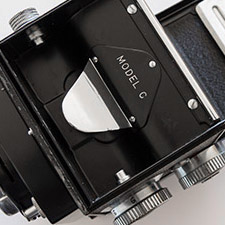
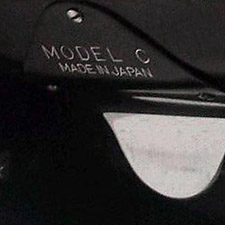 (Right detail from larger web image)
(Right detail from larger web image)
“Model C” is located inside near the feed spool at the bottom of the camera, however, it has only been found on earlier cameras, in general, those with the earlier focusing knob as on the left camera above and below. It appears by itself on cameras with focusing scales in metres. As noted further below, metre scales are by far the most common, and as a consequence, I only have two examples in my database of the early Yashicaflex C with the scales in feet and the feed chamber detail visible. As well as “Model C”, there is “Made in Japan” in both. Presumably this is because the examples with feet scales were for export and also presumably, all early examples with feet scales will be the same, however, that is simply speculation.
(Images courtesy of Tom Heckhaus)
These are larger front views of the two cameras above which represent early and late versions but not the earliest which had the late Yashicaflex A-I/A-II type locking lever, later (1956) also fitted to the Yashica A and Rookie:
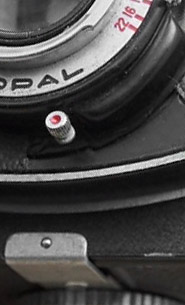 (Detail from larger web image)
(Detail from larger web image)
Note also the subtle difference in the nameplate with the slightly more pinched ends on the later one - the style of that carried over to the Yashica C. As well as the logo between the lenses being in red until near the end of production, so was the aperture scale, a feature Yashima advertised in the above user manual as “permits easy identification for beginners.” The cameras with early focus knobs also uniquely have the DoF apertures on the backplate marked in red and the plastic end caps are already the same as appeared on the later knobs:
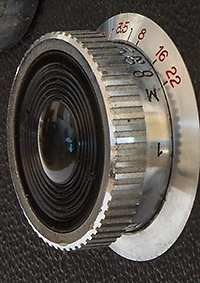
The second earliest example in my database with a lens cap continues the red theme with “Yashica” in red:
 (Detail from larger web image)
(Detail from larger web image)
It is the only one found so far, on later cameras the name is in the standard black as it is on the earliest camera.
For most Yashicaflex C examples, the oval hood logo is silver with red outline and text as it also is on the single Yashicaflex A-III example found. However, four examples with serial numbers in the 540xxx to 545xxx range (approximately in the middle of the model run with the new nameplate style already but amongst the last with the early focus knob still), appear to have the outline and text in black as found on the Yashica Hi-Mec which is from around the same period:
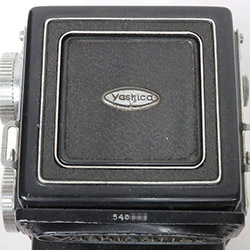 (Detail from larger web image)
(Detail from larger web image)
It may be that more of the cameras in this number range in my database have, what appear to be, silver and black logos but sometimes from some angles, it is hard to tell. Also, I wasn't looking for this feature until far more recently and I haven't kept photos of all examples.
Although the camera was available with focusing scales in both metres and feet, metre scales are far more common. I have seen no evidence of ads or mention in brochures in possible export markets. However, it does appear in Japanese brochures and it is one of the most commonly found Yashicaflex models on Japanese auction sites and therefore probably few were exported even though they turn up on auction sites outside of Japan from time to time. Most probably left Japan in the hands of service personnel. With M/X flash sync switch added to the shutter, a Yashikor viewing lens (how different was this Cooke triplet to the Tri-Lausar Cooke triplet for viewing purposes?) and a fresnel lens under the ground glass, the Yashicaflex C became the Yashica C export model in 1956 and with added exposure meter, it was also the basis of the Yashica LM.
There are 336 Yashicaflex C cameras in my database. The earliest cameras have 8 flags on the film winding knob, side sync, early focus and spool knobs and the first five examples still have 3 screws in the spool knob backing plates. Eighteen of the first Nineteen cameras, with body serial numbers in the range 500xxx to 506xxx and taking lens numbers 117xxx to 238xxx and 306xxx to 308xxx, have the locking levers of the late Yashicaflex A-I/ A-II type as noted above. The next cameras, plus earlier camera 504xxx, have the bent strap locking levers of the late Yashicaflex S and AS-II and subsequent models.
Note: There appear to be up to three series of lens numbers running concurrently and it seems to be pot luck which numbers are used, i.e., taking and viewing lens numbers can be similar, or one or the other can be from high, mid or low range numbers. Whether Yashikor or Tri-Lausar seems to make no difference. By camera 592xxx with taking lens 629xxx, only one range seems to be in use but the order is still not very consistent.
Example 509xxx has taking lens 227xxx. Camera 530248 is the last with the earlier style nameplate but the first with the new style is actually 526xxx. At 544xxx, the sync moved to the front and the focus knob and depth of field scale changed to the later type but at least one camera 545xx reverts to the earlier features. Camera 549xxx is the last with 8 flag film reminder. At around 576xxx, the number of screws in the accessory shoe changed from 3 to 4 (577xxx is momentarily back to 3).
With camera 593xxx, the “Yashica” in the oval between the lenses and the aperture scale changed from red to black. This camera is also the first with moulded instead of bent strap locking lever but three of the last 16 Yashicaflex model C examples in my database revert to the earlier type. The final camera in the series is 599xxx with lenses 812xxx and 794xxx.
There is one more, a real oddity. It has serial number 690xxx with taking lens 282xxx. It is crystal clear and much higher than any other number. The nameplate can only belong to a Yashicaflex C. Its features are much earlier with e.g., early focus knob, side sync and “Model C” inside. My only thought is that the nameplate has become lost or damaged and this is an item from Yashima's spares department. I haven't included this number in my Serial Numbers page.
Yashicaflex A-III
Rare mid-range model with high spec shutter
Probable release date |
1955 |
Probable end date |
? |
Lens |
Filter Mounts |
Frame Counter |
Shutter |
|||
Make/Type |
Sync |
S/Timer |
Speeds |
|||
Yashikor |
32 mm |
Counter
|
Seikosha MX (Rapid) |
M/F /X |
No |
B,1-1/500 |
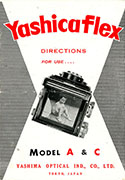 (Click on cover for PDF of full manual)
(Click on cover for PDF of full manual)

I have seen the Yashicaflex A-III mentioned once only by Yashima and that is in the above user manual. In fact it was first identified in that document by contributor Tom Heckhaus. I am also not aware of any other site or reference that has identified this model other than subsequent mention in Camerapedia by myself. The only example I have come across was found on a Japanese auction site in 2015. Its trim seems to match the early 1955 Yashicaflex C including the red aperture scale and the red “Yashica” in the oval between the lenses. It also has the Yashicaflex C focusing hood logo but with only one found, it is not possible to be certain that this is original, although there are no signs of tinkering (what is thought of as the “Yashicaflex C” hood logo is not unique to that model, it also appeared in black and chrome on the 1956 Yashica Hi-Mec). Film wind is auto-stop with film counter and reset button. Because of the name, it is sometimes confused with the 1959 Yashica A III, a Japanese market version of the Yashica A, a much more basic camera.
This is the first model to feature a “Yashikor” branded viewing lens as well as Yashikor taking lens - the Yashicaflex model C still featured a Tri-Lausar viewing lens, although as I have mentioned elsewhere, that distinction was probably more related to marketing than to perceptible differences between two Tomioka f/3.5 triplet viewing lenses.
It is also the only Yashima model to feature the Seikosha shutter which is said to be “inspired” by the German made Synchro Compur. Yashima specs quote the shutter model as the “Seikosha Rapid” with “Flash Synchronization (MX)”. My understanding is that the Rapid with M/X flash sync (actually M/F/X) is called the “Seikosha MX”, as below. There is no self-timer:




Note the “M/F/X” sync switch, the “F” being for short duration flash bulbs. At the time, the highest shutter speed on any other Yashima TLR was 1/300 and only X sync was available. The 1/500 top speed, inclusion of slow speeds, sync switching and the better Yashikor lenses sets this model apart from the very popular (in Japan) A-II but without Bay 1 filter mounts and a self-timer, it probably still sits below the Yashicaflex C (also very popular in Japan). Considering its extreme rarity, the A-III does not appear to have been a great commercial success for Yashima.
Later models with plain filter mounts and faceplate over the shutter have larger 36 mm filter mounts but this camera has the standard 32 mm mounts. The lens cap is the silver metal push-on type typical of the early A series cameras:

The serial number is 118325 with taking lens 215846 and viewing lens 322682. The focusing scale is in metres.
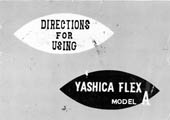
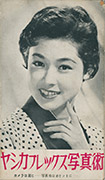


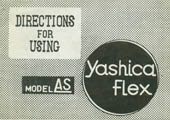
.jpg)
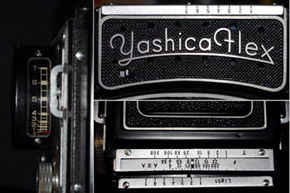
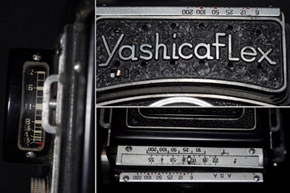
.jpg)
.jpg)
.jpg)
.jpg)
.jpg)
.jpg)
.jpg)
.jpg)
.jpg)
.jpg)
.jpg)
.jpg)
.jpg)




